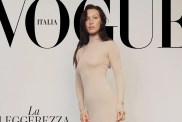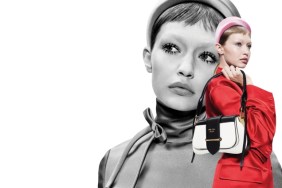Two of my favorite movies revolve around the fashion publishing scene. Funny Face, released in 1957, is the story of a bookish Plain Jane discovered by a fashion photographer. Fifty years later we have The Devil Wears Prada, the story of a Plain Jane writer who becomes the assistant to a high powered female fashion editor. Both of these films take us behind the scenes and into the production process of fashion magazines. Both stories revolve around young women who find themselves realizing that fashion is more than just “silly dresses and silly women”.
But while Funny Face is a fresh and invigorating romp through Paris,The Devil Wears Prada can make you feel as if fashion were a soulless enterprise where only the evil can survive.

In Funny Face, we meet irrepressible editor Maggie Prescott (played with patrician verve by Kay Thompson), who rules over Quality Magazine. Dressed in a well-tailored, but matronly suit (skirt well below the knee), she sings and dances about the glories of the color pink. Her assistants laugh and chatter around her – a mob of pretty girls who folow her every order as if it were handed down on stone tablets. Maggie grabs head photographer Dick Avery (played by Fred Astair, and based on Richard Avedon) and drags him off to a bookshop for an impromptu photo shoot. There they encounter a scruffy little bookworm named Jo Stockton (the lovely Audrey Hepburn in a horrible wool shift and brown skirt), and coerce her into letting them shoot in the store. Back at the office, they decide that her ‘funny face’ is perfect for the new Quality Woman campaign, and whisk her off to Paris, where she finds herself becoming a model and falling for Dick. In the end, after many production numbers and mad hijinks, she and Dick sail off into the sunset.

Her intelligence adds to her beauty as she takes direction from the photographer, playing different roles and taking on multiple personas in order to bring the clothing to life. What’s wonderful about the character is that she brings a certain conviction to her role, and refuses to dumb-down in order to be a mannequin. She is a young girl who has been handed a great opportunity and takes it, then throws herself into it with abandon and verve,coming to love her new position. As she floats down a flight of stairs trailing a brilliant red scarf she tells Dick ‘I don’t want to stop, I like it. Take the picture!’ She retains control of herself and achieves success on her own terms.
By contrast, Andy Sachs (played by Anne Hathaway) of The Devil Wears Prada is a girl who has no control over herself, her career, or her life. We learn that she was accepted to Stanford Law, and that she was a journalist for the newspaper at her mid-western college. But for all her intelligence, Andy never seems to have (or be able to get) a clue. In the opening montage we see her getting dressed with no real thought to her grooming or presentation. She eats an onion bagel on the way to a job interview. And after obtaining the job that she begged for, does nothing but complain about it throughout the film.

As the assistant to Miranda Priestly (an amazing performance by a wigged Meryl Streep), she is privy to decisions made by the top people at Runway Magazine. Miranda is a demanding perfectionist, and Andy struggles with the job and with the pressure put on her to conform to Miranda’s standards.
In one telling exchange she tells Nigel (played by the wonderful Stanley Tucci), the magazine’s art director, that “Miranda hired me, she knows what I look like’. His response of “Do you?” is a key to the secret of the movie. Fashion is not just what you look like, but how you see yourself. When you watch the film, you come to understnd that Andy (and those that are closest to her) sees herself as unattractive and makes no real move to change until Nigel gives her a tough love speech about her whining.
She then begins her physical makeover, but she never really manages to see herself as someone who can be in the fashion world. Her family and friends don’t help, constantly bullying her and berating her at a time when understanding and insightful advice would have been better. No one encourages her.
Every time I watch this film, I can’t help but feel that they are jealous and worried that if Andy does embrace this new world, she will achieve a success that dwarfs everyone else’s. It’s always sad to see her crawl back to her judgemental boyfriend, eating a huge helping of humble pie. I always wish that she had walked away from him permanently, and not away from her job as Miranda’s assistant. She gave up on something that could have made her great, to return to what was familiar and safe.

Funny Face’s Jo Stockton is a multi-layered character with intelligence and integrity. You can see her becoming a leader, and using her modeling to change the world. In the modern day fashion film, The Devil wears Prada, we meet a young woman who has no clear sense of herself or her place in the world. She looks to everyone else for approval and affirmation, but never takes the time to really look inside of herself. She has no real power over anything that happens to her, because she refuses to take responsibility for herself and her actions.
Her brief time working at Runway changes her, but in the end she doesn’t have her boss’s strength to survive. Andy could have used Runway to make a real difference, bringing her intelligence to a place where it could be valued and nurtured, but in the end she runs away, afraid of her own capacity to succeed.
How fitting that the last word spoken in the film is by Miranda Priestly as she impatiently tells her driver to “GO!”, since she’s the most powerful and fully realized character in the film. The Devil Wears Prada enforces the idea that fashion today is a tense, catty world where only those that are willing to sacrifice everything can prosper. I guess that’s progress?





